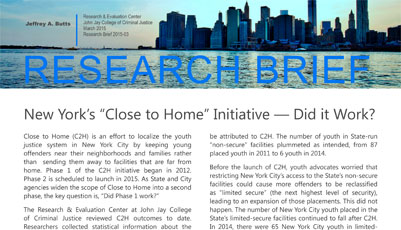
New York, NY, March 16, 2015 – The Research and Evaluation Center at John Jay College of Criminal Justice recently reviewed the outcomes of “Close to Home,” New York’s juvenile justice reform initiative to localize the youth justice system in New York City. The study suggests that Close to Home (or C2H) – launched in 2012 –successfully changed the youth justice system in New York City, and in the way intended by designers of the reform.
New York implemented the first phase of C2H by bringing home New York City youth from the State’s “non-secure” programs. A second phase, scheduled to begin in late March 2015, will bring back youth from “limited-secure” programs that house a more serious group of offenders.
The findings of the John Jay study include:
- Close to Home appears to be an effective strategy. Three years after the implementation of Phase 1, C2H retains strong support from State and City officials, youth justice practitioners, and advocates.
- C2H was not designed as a cost-cutting reform, but many officials believe it will eventually make youth justice more cost-effective by generating better outcomes and lowering crime.
- New York City now operates more (and likely better) placement facilities for justice-involved youth. Advocates, however, worry that the full array of community alternatives remains under-utilized.
- It is too early to tell whether C2H truly reformed New York City’s justice system and improved public safety. The success of the initiative cannot be assessed simply by tracking changes in the number of youth placements. New York City placements are down sharply, but the decline started years before the implementation of C2H. Some key trends, however, are promising. For example, probation intakes and detention admissions have dropped more in the City than in the rest of the State.
- After three years of reform, as well as a new Mayor and City administration, Close to Home appears to be established policy. All stakeholders are eager to maintain the effort.
To read the full report, click here.
According to Jeffrey Butts, director of the Research and Evaluation Center at John Jay College, “we are happy that the Robert Sterling Clark Foundation supported this study at this time because the State and City are about to embark on an expansion of Close to Home and it is time to review the effectiveness of the initiative so far.”
C2H brings young offenders home from far-away correctional institutions and allows them to be placed in residential facilities or supervised in community-based programs closer to their families. When justice-involved youth are supervised by local agencies and placed with local programs rather than being sent to far-away state facilities, they are better able to maintain community ties. They are more likely to stay connected to their families and to remain in local schools.
The Research and Evaluation (R&E) Center is an applied research organization that provides members of the academic community at John Jay College with opportunities to respond to the research needs of justice practitioners in New York City, New York State, and the nation. The R&E Center provides direct assistance to agencies in the justice system, designs and carries out studies of innovative strategies to prevent and reduce crime, and works to improve the effectiveness of interventions at the individual and community level.
About John Jay College of Criminal Justice: An international leader in educating for justice, John Jay College of Criminal Justice of The City University of New York offers a rich liberal arts and professional studies curriculum to upwards of 15,000 undergraduate and graduate students from more than 135 nations. In teaching, scholarship and research, the College approaches justice as an applied art and science in service to society and as an ongoing conversation about fundamental human desires for fairness, equality and the rule of law. For more information, visit www.jjay.cuny.edu.



